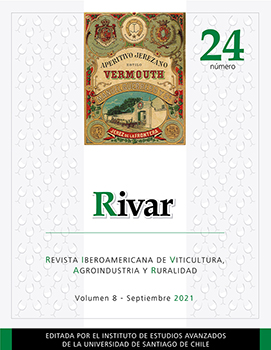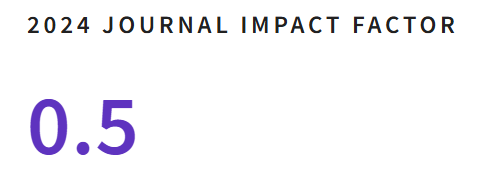Metanol en el mezcal: ¿es posible aumentar los umbrales permitidos por la normativa mexicana?
DOI:
https://doi.org/10.35588/rivar.v8i24.4886Palavras-chave:
mezcal, agave, standards on alcoholic beverages, methanol, toxicityResumo
The allowed limits of methanol by Mexican norms for mezcal set the maximum at 300 mg/100 ml of alcohol 100%. The standard was established in 1986 taking wine as reference. The Norm NOM-142-SSA1-1995 maintains that value today, although in Europe, then and now, the limits for methanol in distilled fruit beverages are well above the content permitted by Mexican Standards. We review the toxicology of methanol and the process of making norms about the allowed contains in alcoholic beverages in Mexico and other countries, and concluded that is possible a revision of standards on methanol maintaining health requirements. The article proposes the revision of the current Norms for the agave distillates, taking mezcals as a case study. We remark that it represents an opportunity for certain traditional beverages (fermented and distilled) that exceed the present standard level.
Downloads
Referências
Andraous, JI.; Lindemann, DJ.; Berglund, KA. and Claus, MJ. (2004). “Effect of Liquefaction Enzymes on Methanol Concentration of Distilled Fruit Spirits”. American Journal of Enology and Viticulture 55(2): 199-201.
Bauer-Christoph, C.; Christoph, N.; Aguilar-Cisneros, BO.; López, MG.; Richling, E.; Rossmann, A. and Schreier, P. (2003). “Authentication of Tequila by Gas Chromatography and Stable Isotope Ratio Analyses”. European Food Research & Technology 217(5): 438-443. DOI https://doi.org/10.1007/s00217-003-0782-4
Bindler, F.; Voges, E. and Laugel, P. (1988). “The Problem of Methanol Concentration Admissible in Distilled Fruit Spirits”. Food Additives and Contaminants 5(3): 343-351. DOI https://doi.org/10.1080/02652038809373713
Clary, J. (2013). The Toxicology of Methanol. Hoboken, John Wiley & Sons.
Colunga-García Marín, P.; Zizumbo-Villarreal, D. and Martínez Torres, J. (2007). “Tradiciones en el aprovechamiento de los agaves mexicanos: una aportación a la protección legal y conservación de su diversidad biológica y cultural”. In Colunga-García Marín, P.; Larqué Saavedra, A.; Eguiarte, L. and Zizumbo-Villarreal, D. (eds.). En lo ancestral hay futuro: del tequila, los mezcales y otros agaves. Mérida, CICY-CONACYT-CONABIO-INE: 229-248.
Douglas, M. (1996). Cómo piensan las instituciones. Madrid, Alianza.
FDA (1996). “Food and Drug Administration 21 CFR Part 172, Food Additives Permitted for Direct Addition to Food for Human Consumption; Dimethyl Dicarbonate. Federal Register 61(104) Wednesday, May 29, 1996. Rules and Regulations”. Authenticated U.S. Government Information GPO. En https://www.govinfo.gov/content/pkg/FR-1996-05-29/pdf/96-13303.pdf (accessed 09/10/2019).
García Mendoza, AJ. (2007). “Los agaves de México”. Ciencias 087: 14-23.
Giersiepen, H. (2017). The spirit of Agave: Mezcal. Master Thesis. Hochschule, Geisenheim University.
Hang, Y. and Woodams, E. (2010). “Influence of Apple Cultivar and Juice Pasteurization on Hard Cider and Eau-de-Vie Methanol Content”. Bioresource Technology 101(4): 1396-1398. DOI https://doi.org/10.1016/j.biortech.2009.09.069
Hernández López, JJ. (2018). “El mezcal como patrimonio social: de indicaciones geográficas genéricas a denominaciones de origen regionales”. Em Questão 24(2): 404-433. DOI https://doi.org/10.19132/1808-5245242.404-433
Hodson, G. and Wilkes, E. (2016). “The Regulatory Example of Methanol in Wine”. APEC Wine Regulatory Forum. Ottawa, Canada, October 6th and 7th.
Infobae (2020). “Cifra de muertes por alcohol adulterado en México sube a 18”. Infobae. In https://www.infobae.com/america/agencias/2020/06/09/cifra-de-muertes-por-alcohol-adulterado-en-mexico-sube-a-18/ (accessed 20/08/2021).
Jacobsen, D. and McMartin, KE. (1997). “Antidotes for Methanol and Ethylene Glycol Poisoning”. J Toxicol Clin Toxicol 35(2): 127-143. DOI https://doi.org/10.3109/15563659709001182
Kavet, R. and Nauss, KM. (1990). “The Toxicology of Inhaled Methanol Vapors”. Critical Reviews in Toxicology 21(1): 21-50. DOI https://doi.org/10.3109/10408449009089872
Kirchmayr, MR. (coord.). (2014). Manual para la estandarización de los procesos de producción del mezcal guerrerense. Guadalajara, Centro de Investigación y Asistencia en Tecnología y Diseño del Estado de Jalisco (CIATEJ). In https://ciatej.mx/dyd/manualmezcalguerrerense.pdf (accessed 10/11/2019).
Kostic, MA. and Dart, RC. (2003). “Rethinking the Toxic Methanol Level”. Journal of Toxicology: Clinical Toxicology 41(6): 793-800. DOI https://doi.org/10.1081/clt-120025344
Kruse, JA. (1992). “Methanol Poisoning”. Intensive Care Med 18: 391-397.
La Jornada (2020). “Mueren 36 más por alcohol adulterado en Puebla, Jalisco y Morelos”. La Jornada. Mexico City, May 14th, 2020. In https://www.jornada.com.mx/ultimas/estados/2020/05/14/mueren-36-mas-por-alcohol-adulterado-en-puebla-jalisco-y-morelos-5165.html (accessed 08/20/2021).
Lindinger, W.; Taucher, J.; Jordan, A.; Hansel, A. and Vogel, W. (1997). “Endogenous Production of Methanol after the Consumption of Fruit”. Alcoholism: Clinical and Experimental Research 21(5): 939-943. DOI https://doi.org/10.1111/j.1530-0277.1997.tb03862.x
Matthews, D. (2010). “Development of a Sensitive Method for the Determination of Methanol in Fermented & Distilled Products”. In UVM Food Systems Symposium. Vermont, University of Vermont. In http://www.uvm.edu/vtvegandberry/FoodSystemsSymposium/Matthews.pdf (accessed 11/01/2020).
Monte, WC. (2010). “Methanol: A Chemical Trojan Horse as the Root of the Inscrutable U”. Medical Hypotheses 74: 493-496. DOI https://doi.org/10.1016/j.mehy.2009.09.059
Nava Jaimes, H.; Pezet Sandoval, F. and Hernández Gutiérrez, I. (2001). El Sistema Internacional de Unidades (SI). Los Cués, CNM-MMM-PT-003, Centro Nacional de Metrología.
Nikunjkumar, P. and Kerns, ES. (2017). “Methanol and Ethylene Glycol Poisoning”. In Ferri, FF. (ed.). Ferri’s Clinical Advisor. Philadelphia, Elsevier: 794-795.
Nosko, S. (1974a). “Zur Beurteilung von Williams-Christ Branntweinen”. Deutsche Lebensmittel Rundschau 70: 397-400.
____. (1974b). “Zur Herstellung von Williams-Christ Branntweinen”. Die Kleinbrennerei 26(3): 21-24.
____. (1972). “Zur Beurteilung von ZwetschgenwÄssern”. Die Branntweinwirtschaft 112(4): 133-139.
____. (1969). “Über Erfahrungen bei der Untersuchung handelsüblicher KirschwÄsser”. Deutsche Lebensmittel Rundschau 65(12): 384-388.
OIV (2004). “Contenidos límites de metanol en los vinos”. Resolución OENO 19/2004. Organización Internacional de la Vid y el Vino (OIV). In http://www.oiv.int/public/medias/677/oeno19-2004-es.pdf (accessed 09/05/2019).
____. (1987). “Report of Sub-Commission Analytical Methods”. Bulletin de l’O.I.V. 691-692: 111-114.
Paine, AJ. and Dayan, AD. (2001). “Defining a Tolerable Concentration of Methanol in Alcoholic Drinks”. Human & Experimental Toxicology 20:563-568. DOI https://doi.org/10.1191/096032701718620864
Parlamento Europeo (2019). “Reglamento (UE) 2019/787, sobre la definición, designación, presentación y etiquetado de las bebidas espirituosas, la utilización de los nombres de las bebidas espirituosas€”. Diario Oficial de la Unión Europea. In https://eur-lex.europa.eu/legal-content/es/TXT/?uri=CELEX%3A32019R0787 (accessed 15/09/2021).
____. (2008). “Reglamento (CE) No 110/2008, relativo a la definición, designación, presentación, etiquetado y protección de la indicación geográfica de bebidas espirituosas€”. Diario Oficial de la Unión Europea. In https://eur-lex.europa.eu/legal-content/ES/TXT/?uri=CELEX%3A32008R0110 (accessed 20/09/2021).
Ratz, H. (1966). “Untersuchung und Beurteilung von Steinobstbranntweinen, insbesondere von Kirschund ZwetschgenwÄssern”. Die Branntweinwirtschaft 106: 4-12.
Reinhard, C. (1978). “Beitrag zur Untersuchung und Beurteilung von Obstbranntweinen”. Deutsche Lebensmittel Rundschau 74: 299-301.
Röe, O. (1982). “Species Differences in Methanol Poisoning”. CRC Crit. Rev. Toxicol. 10: 275-287.
____. (1955). “The Metabolism and Toxicity of Methanol”. Pharmacological Reviews 7(3): 399-412.
____. (1946). “Methanol Poisoning, It’s Clinical Course, Pathogenesis and Treatment”. Act Med Scand 182(9): 9-135.
Saldaña Oyarzábal, I. (2006). Carbohydrate Metabolism in the Leaves of the Agave Tequilana (Weber) Plant. Doctoral Thesis. Sussex Oriental, University of Sussex.
Shapira, B.; Schaefer, E.; Poperno, A.; Hess, Z.; Rosca, P. and Berkovitz, R. (2019). “The Methanol Content of Illicit Alcoholic Beverages Seized in a Low Socio-Economic Area of Tel-Aviv: Public Health Impact and Policy Implications”. Journal of Public Health: From Theory to Practice 27(1): 37-42. DOI https://doi.org/10.1007/s10389-018-0922-8
Shindyapina, AV.; Petrunia, I.; Komarova, T.; Sheshukova, E.; Vyacheslav, S.; Kosorukov, V.; Kiryanov, G. and Dorokhov, Y. (2014). “Dietary Methanol Regulates Human Gene Activity”. PLoS ONE 9(7-e102837): 1-16. DOI https://doi.org/10.1371/journal.pone.0102837
Solís-García, A.; Rivas-García, P.; Escamilla-Alvarado, C.; Rico-Martínez, R.; Bravo-Sánchez, MG. and Botello-Álvarez, JE. (2017). “Methanol Production Kinetics During Agave Cooking for Mezcal Industry”. Revista Mexicana de Ingeniería Química 16(3): 827-834.
Soto-García, E.; Rutiaga-Quiñones, M.; López-Miranda, J.; Montoya-Ayón, L. and Soto-Cruz, O. (2009). “Effect of Fermentation Temperature and Must Processing on Process Productivity and Product Quality in Mezcal Fermentation”. Food Control 20: 307-309. DOI https://doi.org/10.1016/j.foodcont.2008.04.006
Wood, C. (1906). “Death and Blindness as a Result of Poisoning by Methyl Alcohol or Wood Alcohol and its Various Preparations”. Int Clin; Quart Clin Lectures 16: 68.
Zhang, H.; Woodams, E. and Hang, Y. (2011). “Influence of Pectinase Treatment on Fruit Spirits from Apple Mash, Juice and Pomace”. Process Biochemistry 46(10): 1909-1913. DOI https://doi.org/10.1016/j.procbio.2011.06.020









